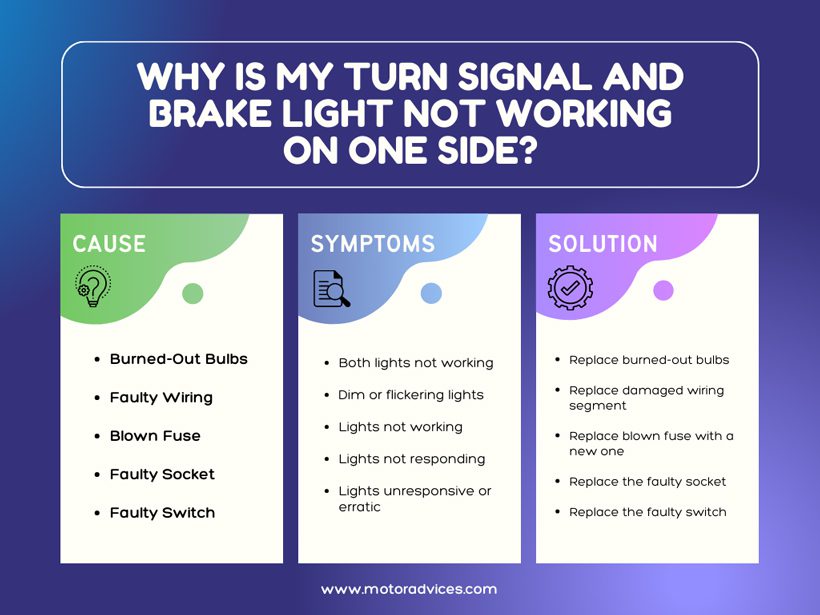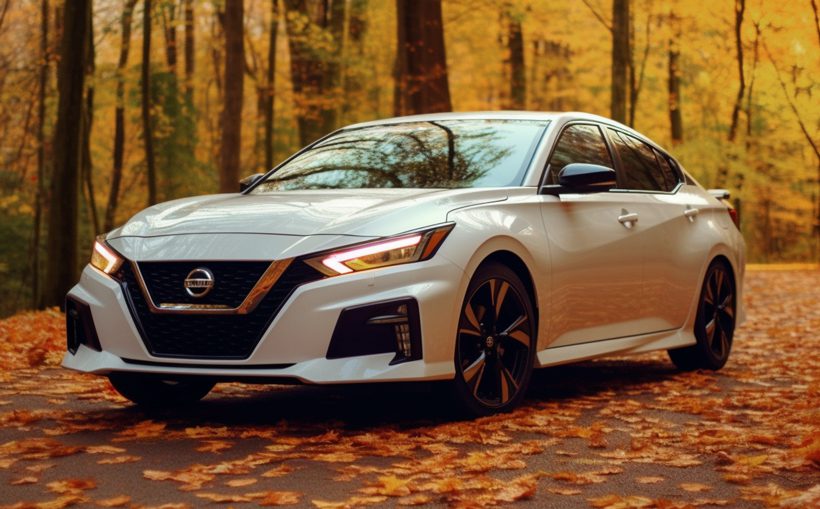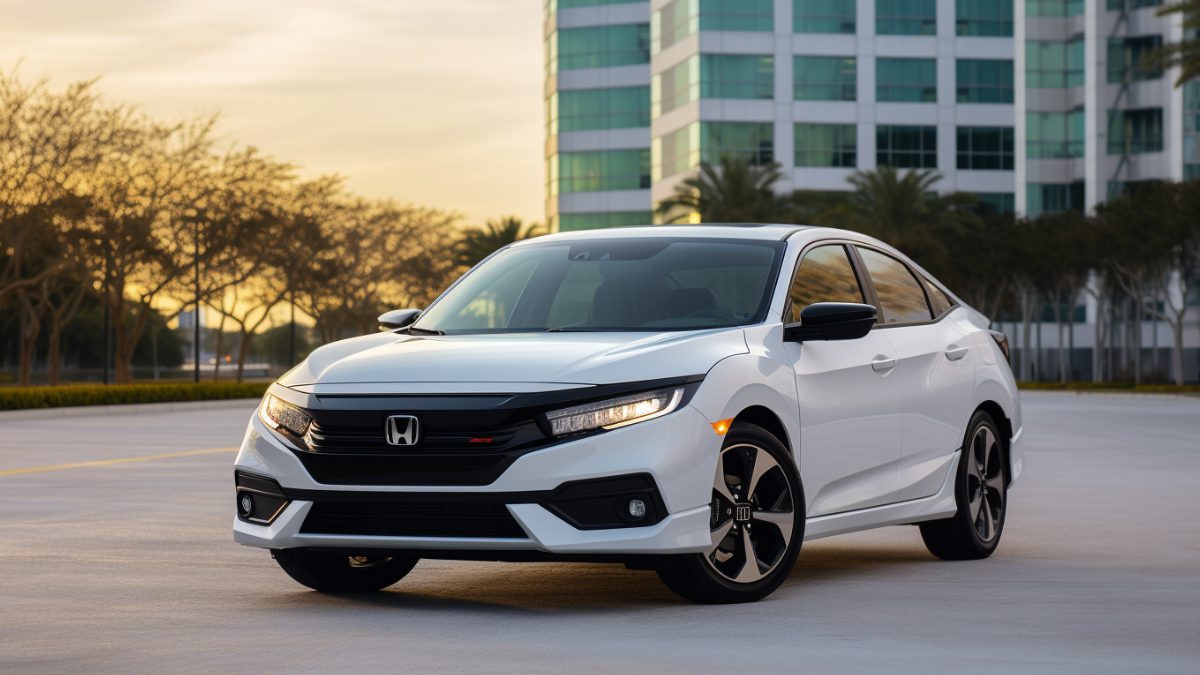Turn Signal And Brake Light Not Working On One Side
Turn signals and brake lights are crucial in communicating your intentions to other drivers. Consider this: you’re driving down the highway, about to make a lane change, but your turn signal and brake light on one side aren’t cooperating.
Now you may wonder, “Why are my turn signal and brake light not working on one side?” A burned-out bulb is the most common cause. These bulbs can burn out over time, causing the lights to stop working. Another likely cause is a blown fuse, corroded sockets or damaged wiring.
This article will guide you through an in-depth troubleshooting process to decipher the reasons behind the turn signal and brake light issue on your vehicle.
An Overview Of Reasons And Quick Fixes On Why Turn Signal And Brake Light Not Working

| Cause | Symptoms | Solution |
|---|---|---|
| Burned-Out Bulbs | Both lights not working | Replace burned-out bulbs |
| Faulty Wiring | Dim or flickering lights | Replace damaged wiring segment |
| Blown Fuse | Lights not working | Replace blown fuse with a new one |
| Faulty Socket | Lights not responding | Replace the faulty socket |
| Faulty Switch | Lights unresponsive or erratic | Replace the faulty switch |
Why Is My Turn Signal And Brake Light Not Working On One Side?

1. Burned-out Bulb
In modern cars, a single bulb serves dual purposes – housing two filaments responsible for both the brake light and the turn signal. When this single bulb faces its end, it takes the brake light and the turn signal down with it. This is evident when the affected light is noticeably dim or completely dark.
Diagnosis:
Access to the affected light housing, which may require removing a cover or panel, depending on the design of your vehicle. Examine the bulb carefully. A snapped or broken filament indicates that the bulb has reached the end of its useful life.

Solution
Change the bulb.
- Step 1: Twist the bulb socket counterclockwise (usually about a quarter turn) to detach it from the housing.
- Step 2: Take the new bulb and insert it into the empty socket. Press the bulb into place until it’s securely seated in the socket.
- Step 3: Slide the bulb socket back into the housing and give it a gentle clockwise twist to fasten it.
- Step 4: Turn on your vehicle’s ignition and activate the turn signal and brake lights of the side you’ve worked on. This is to set if the bulb is working well.
- Step 5: If you had to remove any cover, carefully put them back in place and secure them as needed.
Here is a video to help you out more.
2. Faulty Wiring
You may notice that the affected lights work intermittently or flicker. Alternatively, they may not respond at all. Corrosion, wear and tear, and accidental damage can all contribute to this problem.
Diagnosis:
Start by visually inspecting the wiring leading to the non-functioning lights. Look for exposed wires, breaks in insulation, or signs of damage. If there is no physical evidence of damage, you need to test the wires themselves.
Use a multimeter to determine the presence of power in the relevant wires. If the power checks match your expectations, look into a load equalizer. It is located between the yellow wire and the black wire.
Ensure the connections on both sides are tight. An insufficient or disrupted connection can sometimes result in faulty lighting behavior.

Solution
Fix the faulty wires by following the steps below.
- Step 1: Disconnect the power source before you begin working on the wiring. This might involve disconnecting the vehicle’s battery or switching off the relevant circuit.
- Step 2: Using wire cutters, carefully cut out the damaged or exposed section of wiring.
- Step 3: Cut a section of replacement wire that matches the length of the faulty section you removed. Strip a small portion of insulation from both ends of the replacement wire.
- Step 4: If you’re splicing the replacement wire into the existing wiring, twist the exposed ends and the original wire together.
- Step 5: Slide heat shrink tubing over the spliced area or wrap it securely with electrical tape. If using heat shrink tubing, use a heat gun to shrink the tubing and create a tight, insulated seal.
- Step 6: Use a multimeter to test the continuity of the repaired section.
- Step 7: Reconnect the power source and test the lights to ensure that the issue has been resolved.
3. Blown Fuse
If the turn signal or brake light circuit experiences an overload, it can blow a fuse. The affected lights won’t work at all, and other electrical components might also be affected.
Diagnosis:
Find the fuse box beneath the dashboard or in the engine compartment. Examine the fuse associated with the non-functioning lights.

Solution
Replace the blown fuse.
Step 1: Remove the blown fuse from its socket with a fuse puller or a pair of needle-nose pliers. Avoid employing too much force when gripping the fuse.
Step 2: Insert the replacement fuse and ensure it’s snug and properly seated.
Step 3: Turn on your vehicle and check the turn signals and brake lights to ensure they are working properly.
4. Faulty Socket
Corrosion can interfere with the electrical connection within the socket, resulting in poor light performance. Signs include a dimly lit or flickering light or even the light failing to illuminate altogether.
Diagnosis:
Carefully inspect the socket for signs of rust, debris, or corrosion. A closer look might reveal discolored or damaged contacts within the socket.

Solution
Install a replacement of the faulty socket.
Step 1: Begin by disconnecting the socket from the wiring harness. This might involve releasing clips, removing screws, or gently twisting the socket to detach it.
Step 2: Install the replacement socket in the reverse manner, ensuring a snug and secure connection. Follow the manufacturer’s instructions to ensure proper installation of the socket.
5. Malfunctioning Switch
Most cars use the same circuit for the turn signal and brake light. Therefore, a faulty switch not only leads to malfunctioning turn signals but also brake lights. The malfunctioning could be due to wear, corrosion, or loose connections.
Diagnosis:
A clicking sound can indicate a faulty switch. A multimeter can be used to check the switch’s continuity. This involves determining whether the switch completes the circuit when activated. The switch could be faulty if there is no continuity or erratic behavior.
You will need your vehicle’s wiring diagram to familiarize yourself with where to test for continuity.

Solution:
Replacing a switch is a bit complicated and it is best left to experienced mechanics. However, if you are an experienced DIY, here’s how to go about it.
- Depending on the design of your vehicle, you may need to remove panels or covers to gain access to the switch.
- Then, gently unplug the wiring harness from the old switch. This may entail releasing clips or removing screws.
- Make a note of the wiring connections to ensure proper installation of the new switch.
- Install the replacement switch in the reverse order.
FAQs
Here are more questions vehicle owners may want answers to.
Bulbs are sensitive to oils and contaminants. Handling them with bare hands can result in premature failure due to heat concentration on the oily spots. So gloves prevent this.
No, the brake lights and turn signals are not always the same bulb, but they can be in some vehicles. Some vehicle brands may use a single bulb to reduce the number of switches and wiring.
In Europe, however, cars use two different bulbs: brake lights are red and turn signals are yellow. As a result, having both in the same bulb is difficult.
A brake light is inexpensive and easy to replace. A bulb costs $5 to $10, and labor costs $20, so the total cost will be around $30.
Conclusion
Having problems with your brake lights or turn signals can be extremely frustrating. However, this article has provided you with sufficient information about the causes of turn signal and brake light failure.
You can quickly resolve this problem by following the recommended diagnosis and solutions. Remember that keeping your lighting system in good working order is more than just a matter of convenience; it is also an important contributor to road safety. Also, if you need help fixing something yourself, hire a professional to do it for you.

